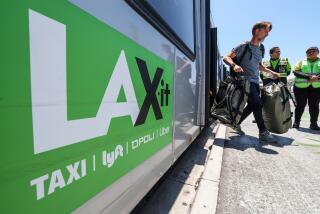MTA’s a bad fit for American Apparel
- Share via
I went to visit the American Apparel warehouses Monday morning in the industrial part of downtown Los Angeles. The two giant warehouses where 5,000 employees work assembling clothes over three shifts sit at the corner of 7th and Alameda, only 1.6 miles from Union Station, which is also on Alameda.
This being Los Angeles -- City of Traffic and Angels -- there is no direct bus service to Union Station. Thus the reason for my visit.
Employees who want to reach Union Station by mass transit have to take a circuitous route that involves walking a few blocks to a bus that travels west into the heart of downtown, where they transfer to the subway. It’s a journey that takes 31 minutes, not counting the initial walk to the bus, according to the Metropolitan Transportation Authority trip planner.
That’s 31 minutes to travel 1.6 miles as the crow flies, which I compute to be 3.2 miles per hour. That’s not slow. That’s Stone Age.
So, American Apparel is in a bind. The company is expecting to do $500 million in business this year and continue to rapidly expand in an industry where most of the jobs have left the United States. It’s one of the largest employers in the city -- there were about 20 people applying for jobs when I visited -- and it’s also stretched thin parking-wise on the land they lease.
“We literally can’t fit any more cars on the lot,” said Ryan Holiday, a company spokesman. He took me up on the roof of one of the warehouses, and it was easy to see his point. There is, however, a giant parking lot on the other side of 7th that is being used as -- drumroll please -- a storage yard for MTA buses.
There are three sides to the story, of course. I couldn’t reach officials with the city’s DASH system to see if they’ve explored relocating a line nearer American Apparel. As for the MTA, the agency had a bus that ran along Alameda but canceled it a few years ago because of poor ridership.
“It was one of the worst-performing bus lines in our entire system,” said Dave Sotero, a spokesman for the MTA. “It’s basically a warehouse district that doesn’t have other sources of ridership to support it.”
Tina Pellegrino, who works on business strategy for American Apparel, said she’s been talking to the MTA and they’ve been encouraging the company to form a van pool. She also said the company is willing to pay for a bus stop -- should a bus line materialize -- and that the company has even looked into buying its own bus -- a costly idea, as it turned out. She also said that Mayor Antonio Villaraigosa’s office has been sympathetic. (And, in fact, the mayor will be at American Apparel this morning to announce some major economic news. He is also chairman of the MTA board.)
One problem is that no one knows how many employees would take a bus if one existed. American Apparel does sell subsidized monthly bus passes to its workers. Company officials said that they spent more than $170,000 last year on bus passes and that at least 400 employees are using that form of transportation. Others have borrowed bikes from the company to get to work.
Still others just walk from Union Station down Alameda Street, said Brenda Cortes, a human resources assistant for the company. “It takes 20 minutes walking,” she said. (By my count, it’s probably a longer walk than that and one filled with much unpleasantness.) “If they take the bus, they have to go around to downtown and make a left or a right, and it gets complicated.”
David Ocampo rides his bike on Alameda -- usually on the sidewalks, even though most are narrow or in embarrassing disrepair. He takes the bus to work from El Monte along the El Monte route and then pedals down Alameda.
I asked him if he had a death wish, and Ocampo -- not wanting to say something wrong in the presence of nearby company officials -- asked me if that was a trick question, although he did say that the firm had run out of monthly bus passes. No, I explained, it wasn’t a trick question. Alameda is barely fit for cars, not to mention bikes or pedestrians.
“It’s good exercise,” Ocampo said. “Maybe if there was a bus that went down Alameda, I would take it.”
That’s the situation. On the one hand, here’s a company providing jobs to the region and that by most accounts has a pretty good package of benefits for its employees -- and many other firms don’t have to pay for mass transit for their employees. On the other, a transit agency that has a responsibility to use its resources in a fiscally responsible manner.
But it seems odd to me that it’s come to this -- that some type of solution can’t be reached, whether it’s partially relocating an existing line or perhaps providing some type of limited bus service. Until then, the situation basically begs employees to drive.
I do know this: When I was finished at American Apparel, I hopped in my car and drove to Union Station. It took me about six minutes.
--
--
--
On latimes.com
All traffic all the time
Steve Hymon covers transportation and commuting in Southern California in real time on The Times’ traffic blog.
latimes.com/bottleneck
More to Read
Inside the business of entertainment
The Wide Shot brings you news, analysis and insights on everything from streaming wars to production — and what it all means for the future.
You may occasionally receive promotional content from the Los Angeles Times.










